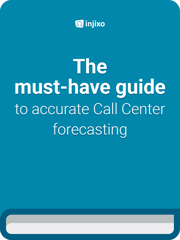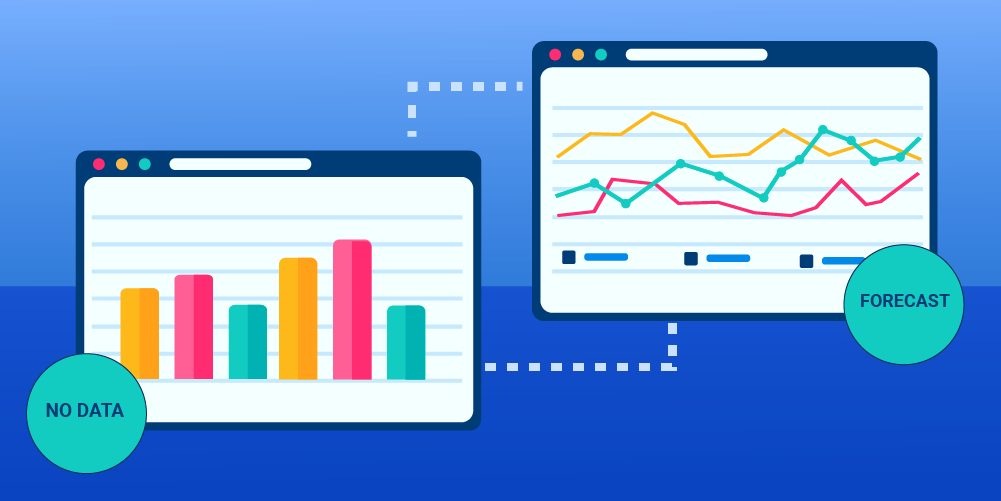Forecasting is the cornerstone of workforce planning. Without forecasting, it’s impossible to calculate the required staffing and consequently, impossible to schedule your agents to consistently cover demand.
In an ideal world, contact centers would always have an accurate forecast of demand for months into the future, down to interval level, e.g. 15 minutes. In reality, this sometimes looks impossible because little or no historical data is available. Should the forecaster, therefore, concede defeat and depend on real-time management to create order from chaos? The short answer is “No!” Read on as we explore the problem and its possible solutions.
In this post, we refer to ‘calls’, but exactly the same principles apply to other contact channels such as web chats, emails, social media messages, and so on.
Problem
Forecasting works by gathering historical data, e.g. call volumes and handling times, then extrapolating from this to predict future demand. The more historical data you have, the more accurate the forecast. As a rule of thumb, we recommend using at least three years of historical data in order to build up a picture of seasonal patterns, together with growth or decline trends.
But what if you don’t have any history, or fewer than 3 years of it? This happens in several situations, including:
- A completely new business with no historical data at all
- A new product or a new contact channel, e.g. introducing web chat or social media messaging, in an existing call center
- Missing data. This can be the result of technical problems or system inadequacies, e.g. only 12 months’ data are available in the database. It can also happen when a line of business that was previously outsourced is brought back in-house and the outsourcer is unwilling or unable to provide its contact history
Solutions
When the annual contact volume is unknown
For completely new start-ups or new lines of business within an existing company, the annual contact volume will be unknown. There are three steps to estimating annual volume:
- Obtain forecasts from your colleagues in sales or finance. It’s likely that departments such as these will have target customer numbers for the new business.
- Estimate the number of contacts that each new customer is likely to make in the course of a year. It helps to identify all the possible reasons to call and individual frequencies in each case.
- Multiply the number of customers by the expected number of calls to estimate the total number of calls per year. Now you can proceed to the next section.
When the annual contact volume is known
- Estimate the number of calls per month. This is important because every contact center experiences seasonality. Many retailers are busy from November to December, travel companies are typically busy in January, and so on. Consider this example: you are in the retail sector and retailers with a customer base similar to yours experience 15% of total annual contacts in November. If your total expected annual contact volume is 200,000, you can expect 30,000 calls in November.
- Estimate the number of calls per day and intraday interval by applying weekly and daily contact distribution patterns. Continuing the above example, if 17% of calls arrive on a typical Monday and 3% of calls typically arrive between 09:00 and 09:30, there will be 153 calls between 09:00 and 09:30 on a November Monday.
To perform these calculations, it’s clear that you will need to have benchmarks, ideally in the same industry, with the same customer base, and even the same opening hours. These centers are likely to experience similar call distribution patterns to yours, even if the volumes differ.

Want to get your call center forecast right?
This guide will provide everything you need to know to get your forecast right and hit your service level goals efficiently.
Average handling time
To calculate the required staffing, it will be necessary to know the expected average handling time (AHT) as well as the volume. Again, comparing notes with your network will provide a good starting point. You should always begin with a conservative assumption, i.e. inflating AHT by a safety margin. Real-life data about AHT will accumulate more quickly than data on total contact volumes and distribution patterns, so you should switch to using ‘real’ AHT data as soon as the metric has stabilized.
Top tips for forecasting without historical data
- Build up a network with which you can compare benchmarks. Connect to industry peers on social networking and join trade bodies for your industry.
- Join planning expert groups such as SWPP, The Forum, and Call Centre Helper.
- Recognize that contact distribution patterns tend to persist over time, e.g. the percentage of contacts made by the day of the week and interval within the day. This applies even if the total volume changes significantly, e.g. as the business grows. You should therefore not be overly concerned if distribution pattern benchmarks are older than volume estimates.
- Share and validate your assumptions with colleagues, both inside and outside the planning function. Tap into the wisdom of your entire organization to ‘sanity check’ the basis of your forecast.
- Document your assumptions, always citing sources. Use proper change control. If you change any assumptions, be sure to keep a record of the change, who made it or suggested it, and why.
- When agreeing on service level targets with the operation, make it clear that the goal is based on estimated customer metrics and document the source of those metrics.
- Start the ‘production’ forecasting process as soon as data becomes available, then compare actuals with your initial forecast and with the production forecast.
- Test your assumptions with experiments to minimize risk. For example, evaluate the impact of launching a new contact channel by first offering it to a subset of customers. This will enable you to learn about the impact on total contact volumes, volumes by channel, and AHT by channel before rolling out to the whole operation.
- Prepare for a large deviation of actual from forecast. Good planners know the value of having a well-defined ‘plan to react’ in their real-time management toolkit. This is especially true when forecasting with limited data. The good news about channels like web chat is that they can be turned off when capacity is limited.
Conclusion
To the uninitiated, forecasting workload without historical data looks like guesswork. It’s easy to believe that even with the most sophisticated calculations, the best you can hope for is a close approximation and you will depend on real-time management to save the day. In fact, there are proven ways to forecast without a complete data set. The secret is to tap into the wisdom of your network, then be as scientific as possible. That way you will find the best possible estimates, recognize the potential sources of inaccuracy, mitigate them and achieve great results, even with scant data.
👉 Further reading
Want to know all about best practices in forecasting? Check out Call Center Forecasting Fundamentals.
Did you find the article interesting and would like to share it with your colleagues? Download the article as a PDF.





